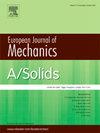基于先进粘弹性基础的改进正弦剪切变形理论的功能梯度生物复合材料圆板波传播分析
IF 4.2
2区 工程技术
Q1 MECHANICS
引用次数: 0
摘要
本研究利用改进的正弦剪切变形理论(ISSDT)研究了功能梯度(FG)生物复合材料圆形板在先进粘弹性基板上的波传播特性。FG生物复合材料由天然纤维和可生物降解基质组成,具有卓越的机械性能和可持续性优势,是航空航天、生物医学和海洋工程结构应用的理想材料。ISSDT考虑了横向剪切变形和厚度拉伸效应,提高了波频散分析的精度。利用Hamilton原理推导控制方程,采用谐波微分正交法沿径向求解,保证了计算效率和精度。详细讨论了材料级配、边界条件和几何参数对相速度的影响。研究表明,增加生物复合材料组分的体积分数可以显著改变波的特性,影响基本波和高阶波的模式。此外,与经典和高阶剪切变形理论相比,ISSDT中包含的厚度拉伸导致了更好的预测。HDQM被证明是一个强大的数值工具,有效地处理与圆形FG板相关的复杂边界条件。这些发现为FG生物复合材料结构的动态行为提供了有价值的见解,指导了其振动控制和波浪操纵应用的优化设计。该研究为可持续复合材料领域的发展做出了贡献,并促进了对FG生物复合材料波动力学的理解。本文章由计算机程序翻译,如有差异,请以英文原文为准。
Wave propagation analysis of functionally graded bio-composite circular plates using an improved sinusoidal shear deformation theory resting on an advanced viscoelastic foundation
This study investigates the wave propagation characteristics of functionally graded (FG) bio-composite circular plates using an improved sinusoidal shear deformation theory (ISSDT) resting on an advanced viscoelastic substrate. FG bio-composites, composed of natural fibers and biodegradable matrices, offer superior mechanical performance with sustainability benefits, making them ideal for structural applications in aerospace, biomedical, and marine engineering. The ISSDT accounts for transverse shear deformation and thickness stretching effects, enhancing the accuracy of wave dispersion analysis. The governing equations are derived using Hamilton's principle and are solved via the harmonic differential quadrature method (HDQM) along with radial direction, ensuring computational efficiency and precision. The influence of material gradation, boundary conditions, and geometric parameters on phase velocities is examined in detail. The study reveals that increasing the volume fraction of bio-composite constituents significantly alters the wave characteristics, affecting both the fundamental and higher-order wave modes. Additionally, the inclusion of thickness stretching in the ISSDT leads to improved predictions compared to classical and higher-order shear deformation theories. The HDQM proves to be a robust numerical tool, efficiently handling the complex boundary conditions associated with circular FG plates. The findings provide valuable insights into the dynamic behavior of FG bio-composite structures, guiding their optimized design for vibration control and wave manipulation applications. This research contributes to the growing field of sustainable composite materials and advances the understanding of wave mechanics in FG bio-composites.
求助全文
通过发布文献求助,成功后即可免费获取论文全文。
去求助
来源期刊
CiteScore
7.00
自引率
7.30%
发文量
275
审稿时长
48 days
期刊介绍:
The European Journal of Mechanics endash; A/Solids continues to publish articles in English in all areas of Solid Mechanics from the physical and mathematical basis to materials engineering, technological applications and methods of modern computational mechanics, both pure and applied research.

 求助内容:
求助内容: 应助结果提醒方式:
应助结果提醒方式:


